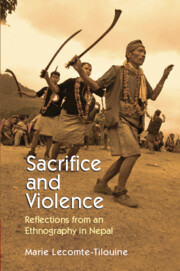Book contents
- Frontmatter
- Contents
- List of map and figures
- Note on transliteration
- Acknowledgements
- Map
- Introduction
- 1 A violence that is not violence
- 2 Theories of sacrifice, with or without violence
- 3 Sacrificial violence in narrative forms
- 4 Sacrificial practices and partitions
- 5 The buffalo sacrifice
- 6 Contestations of sacrifice: boycott and litigation
- 7 Self-sacrifice versus sacrifice in the revolutionary struggle
- Conclusion
- References
- Index
6 - Contestations of sacrifice: boycott and litigation
Published online by Cambridge University Press: 28 November 2024
- Frontmatter
- Contents
- List of map and figures
- Note on transliteration
- Acknowledgements
- Map
- Introduction
- 1 A violence that is not violence
- 2 Theories of sacrifice, with or without violence
- 3 Sacrificial violence in narrative forms
- 4 Sacrificial practices and partitions
- 5 The buffalo sacrifice
- 6 Contestations of sacrifice: boycott and litigation
- 7 Self-sacrifice versus sacrifice in the revolutionary struggle
- Conclusion
- References
- Index
Summary
The dissensions which go hand in hand with the unfolding of sacrifice begin to take on new forms which reach beyond the executions themselves, after the promulgation of the 1990 Constitution. This democratic turning point in the history of Nepal led to a weakening of the monarchy and to critics of the ‘sacrificial’ organisation of society. The questioning of consecrated forms of violence within a renewed political framework already occurred after the fall of the Rana and the opening of the country to foreigners in 1951. At that time, a first democratic regime which lasted from 1951 to 1959 led to the introduction in 1963 of a new code of law in which the notion of caste and its associated notions of social pollution and contamination were expunged. Following the 1990 Constitution, which re-established political parties that had been banned for thirty years, the Indigenous peoples organised themselves into associations to work towards their emancipation. From them emerged the very first organised protest against sacrifice, targeting Dasaĩ, the supreme moment of the reaffirmation of Hindu power. The Untouchable castes, now federated under the name Dalit, also created associations for the defence and promotion of their group, which advocated boycotting the consumption of sacrificial remains. And animal sacrifice finally became the object of growing opposition in urban and educated circles, who began to contest its violence. In this arguably more diffuse type of activism, the opposition to sacrifice is the most radical, in the sense that it does not target the place or role of a group in the sacrificial system, but its actual core, the ritual killing of animals itself. From this point on, conflicts over sacrifice became more than disputes over local issues of power and governance, with each of the protesting groups supported by an ever-growing network, the most extensive of which being the ‘anti’ animal killing, who combine followers of a purified Hinduism, as practised in India, and international animal rights organisations, both of whom advocate vegetarianism.
In this second context of democratisation the Nepalese Maoist party developed during the second half of the 1990s, growing so large that they ended up eclipsing the entire political landscape.
- Type
- Chapter
- Information
- Sacrifice and ViolenceReflections from an Ethnography in Nepal, pp. 162 - 192Publisher: Cambridge University PressPrint publication year: 2024

